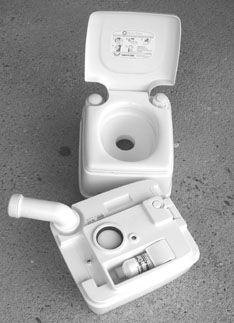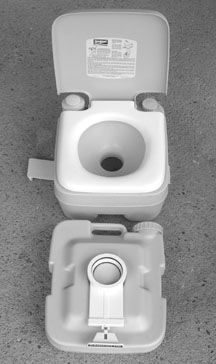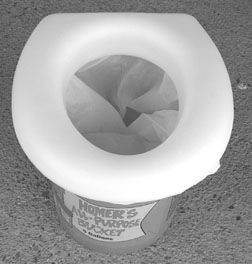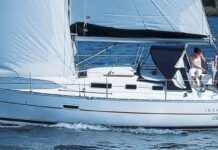
Aboard boats, head is indeed a four-letter word. Nothing good about ’em. They stink, leak, clog and break down. Not at all like your residential toilet that just seems to keep flushing as reliably and tirelessly as the Energizer bunny bangs his drum. But, of course, you have to have a head…or do you?
We’ll explore that question vis a vis several products that aren’t much more than buckets—or bags—with lids. First, however, we’ll examine four popular portable toilets, whose low cost and utter simplicity might make you think twice about your “real” marine head, with pumps, hoses, springs, valves, through-hulls and myriad other failure-prone parts.
The Case for the Porta Potty
The portable toilet was developed not only for small boats but also recreational vehicles, campers, and just about any place regular plumbing either isn’t available or isn’t wanted. If Thetford wasn’t the inventor, this company did much to popularize the product, coining the term “porta potti” that is now universally applied to all brands, like Kleenex is to tissue. Out of respect for Thetford, when we refer to portable toilets in the vernacular, we’ll spell potty with a y—porta potty.
The beauty of the porta potty is the almost total elimination of moving parts. The only ones of consequence are the pump that draws fresh water from the upper tank and rinses the bowl, and the handle-rod-valve assembly that opens the trap for waste to fall from the top tank/bowl into the bottom tank.
In the U. S., a distinct appeal of the porta potty is the U.S. Coast Guard’s recognition of it as a “legal” head. That’s because of its built-in, albeit small, holding tank. This logic doesn’t fly in the province of Ontario, Canada, and some U.S. states, however, which stipulate that the unit must be permanently installed. But simply installing hold-down brackets, optional with SeaLand and standard with the marine Thetford unit we tested, isn’t enough; the toilet also must be plumbed. SeaLand’s SaniPottie 964MSD/965MSD models include the fittings necessary to discharge waste from the built-in tank to another remote holding tank, or deck fitting for dockside pump-out. You’d have to buy the connecting hose, of course. A 5/8″ through-hull vent fitting is supplied as well. Thetford also offers MSD versions. (MSD stands for Marine Sanitation Device; see sidebar pg. 14.)
Portable toilets are inexpensive; three of the units tested here cost less than $100.
Now for the downside to portables. Capacity is limited. Holding tanks in these models range from about 2-1/2 gallons up to 6. Depending on the size of your crew, and how much food they’re consuming (or beer), such small tanks can fill quickly. If you’re still at sea, what do you do then? Dumping these into the lake or ocean (inside the 3-mile limit) is illegal.
It is therefore best to think of portable toilets as day toilets, for use on small boats that return to the dock each or every other night, where the tank can be emptied into a shoreside toilet. And that’s the second disadvantage: You do have to look at, and smell, the waste as it pours out of the tank. But, if you use the recommended chemicals in the holding tank, the waste is broken down, colored (usually blue) and deodorized to the point that you won’t gag.
Third and fourth disadvantages: Spills occasionally will happen, say on the bathroom floor of your marina, and require clean-up. And you’ve got to lug the tank up and down the dock, or on and off a trailered boat, a minimum of around 22 lbs. in our test.
Nevertheless, porta potties are marvelous little devices that are much appreciated on the boats in which they serve.
What We Tested
This is the third time in 12 years that PS has tested portable toilets, the previous evaluations taking place in 1993 and 2002. The players remain the same: Thetford, SeaLand (now owned by Dometic), and Sanitation Equipment, which makes the Visa Potty. The design and manufacture of each unit remain essentially unchanged, but this time we looked at the very simplest models from SeaLand and Thetford, rather than the MSD models tested in 2002. And we tried to take a fresh look at the common features of each.
While thumbing through the West Marine catalog, we also noted several new products we thought worthy of examination: a rotomolded polyethylene seat that fits over most any bucket, and the PETT, a fold-up camp toilet that uses bags and a chemical that solidifies waste.
How We Tested
In deciding how to evaluate these inexpensive toilets, we focused on how most people use them, and the issues that are of obvious importance. These lead us back to the disadvantages listed above: capacity, weight, and spills. Capacity and weight are, of course, directly related: The more capacity, the more the filled tank weighs. So the advantage of a large holding tank, which requires less frequent emptying, is partially negated by having to lift its heavier weight. A dolly or dock cart would come in handy here.
Your decision on capacity is probably a personal one, varying with how big and strong you are, the number in your typical crew, and so on.
We measured capacity, and weighed the filled tanks so you have a basis for comparison.
Each toilet was filled and flushed, with the number of strokes counted. This gives an idea of how much water is flushed with each stroke, and that is useful information in relation to how well the bowl is rinsed, and the number of flushes one might expect. (Strokes were counted to empty the top tank, or fill the bottom tank, whichever came first.) But there are variables for which one can’t easily account. For example, urine requires perhaps one pump stroke to flush, whereas a stool may require half a dozen, depending on whether you first wet the bowl or not.
We then emptied that tanks, noting convenience of the caps and spouts, vents, and spillage.
Lastly, mention is made of the various features, such as level indicators, caps, and locking mechanisms.
Thetford Porta Potti 735
Though it’s difficult to tell, the two Thetford models tested are from different model series, each with half the tank capacity of Thetford’s larger AquaMate models. The 735 is from the marine series and comes with hold-down brackets and a tank level indicator. It holds just 2.6 gallons in each tank, the lowest number of the four models tested. Yet it required the most strokes to empty the top tank, meaning that less water is used with each stroke—about 2 ounces. You can look at this two ways: either the 735 conserves water best, or requires more strokes to flush. Frankly, we wished for a little more flow from this pump; none of these toilets pump easily. The bellows pump depresses just an inch or so. The company says it’s good for about 27 flushes; that’s six strokes per flush.
The fill cap is a non-threaded twist lock with side vent. Every toilet has one, and water can leak out the pinhole if tilted too far. Water also can leak out the flush tube in the bowl, but shouldn’t if you carry the upper tank by its handle.
The two tanks are secured by a sliding lever on the back side of the toilet; at first, it isn’t immediately obvious which way one should push the lever, but you have only two choices, right?
The permanently attached pour-out spout works very well and is less likely to splatter than those with caps directly on the tank.
The holding tank level indicator is a green gauge that turns red when full. Handy, but honestly, you’re probably going to have a visual of the tank contents every time you use the toilet.

Hold-down brackets come with the toilet.
Bottom Line: We like the pour-out spout, but its price and limited tank size are drawbacks.
Thetford 155
The 155 is a non-marine model, but has many features in common with the 735. One big difference is its larger holding tank—4.3 gallons versus 2.6 gallons. This means it is more than 2 inches taller, which, unless vertical space is critical, is a double bonus because it makes sitting a little easier. (The 135—which PS didn’t test— has the same size holding tank as the 735 and sells for $10 less than the 155.)
The holes in the seats of the two Thetford models are the narrowest at just 7-1/2 inches, so people with big bottoms—even average ones—may find the Sanipottie or Visa Potty more comfortable, or a larger Thetford model such as the AquaMate series. Men, in particular, may find that there isn’t room for Mr. Ding-a-ling to dangle.
Molded into the top of the bottom tank is a deodorant storage compartment, which is handy, we guess, though you’ll probably want to carry more than just one bottle, so you’ll be stowing supplies elsewhere anyway.
The locking mechanism, rotating pour-out spout, and other features, are the same as on the 735, including the button you press to vent the bottom tank when emptying. The vent is an important feature since you can’t empty the tank without it open. The rest of the time, especially when carrying the waste tank, you want it closed so nothing leaks out. Because you need to use two hands to empty the tank, you must depress the button with the thumb of one hand. It works.
The flush tube in the bowl of our unit was aimed a bit high; with aggressive pumping, water ran over the top of the bowl and down the side of the toilet.
Bottom Line: A better buy than the 735, with almost twice as much tank capacity.
Sanipottie 964
The grayish-colored Sanipottie doesn’t look quite as clean or shiny as the Thetford potties, perhaps because it is made of blow-molded polyethylene instead of injection-molded polypropylene. As we pointed out in the previous reports, blow-molded tanks have no seams to be joined and the insides are uncluttered and easier to clean (usually by spraying a hose inside and rinsing several times). This also enables SeaLand to use an external slide valve mechanism threaded to the top of the waste tank that remains free of waste contamination.
The vent in the top tank is a pinhole in back of the seat. The bottom tank has no vent, which means waste may burp a little when emptying, though we found little splashing in our tests.
Like the Thetford toilets, pumping is much easier if you close the seat and cover, which otherwise obstruct your hand. Okay, so you didn’t want to look at the waste anyway, but now you can’t tell when the bowl is thoroughly clean. You have to lift the lid and take a peek.
Unlike the other three toilets, the Sanipottie holds more water in the top tank than in the bottom. This means you’ll have water left over, though not enough, probably, to avoid filling it at the same time you empty the bottom tank. Seems like the extra capacity could have been given to the bottom tank instead.
The bellows pump pushes nearly 4 oz. of water per stroke, the most of the four toilets. Flushing action doesn’t cover as much of the bowl as the others, and that can be a problem.
The tank-locking system uses two latches that seem easier to use than Thetford’s rear-mounted lever, though sometimes they fold under and one must fumble with them for a moment to get them free.
Optional hold-down brackets sell for around $20.
Bottom Line: Nice price, but there are better flushers.
Visa Potty 248
Largest of the four toilets, the Visa Potty 248 has a generous seat compared to the others. Its 4.8-gallon waste tank weighs 40 pounds full.
The mechanism that locks the two tanks together is simply two molded snap-flaps on the top half; set the top tank on the bottom and push. To unlock, pull out the flaps and lift. It works pretty well, if a little sticky at times, but if one of the flaps breaks, you’re screwed.
The top tank has no handle so one must grab it by the lip, which isn’t very comfortable.
The fill cap with vent hole simply presses on, but it surprised us by staying secure even when the tank was turned upside-down. The waste tank vent is a push-pull valve that is easy to operate—no thumb needed.
The Visa Potty comes with a drain spout that stores on top of the waste tank. You don’t need to use it, but it helps. Unlike the Thetford spouts, which are permanently affixed to the tank, you must screw on the Visa spout each time, and then remove it.
Where the other three toilets have bellows to pump, the Visa has a piston pump, advertised as being “bi-directional,” though little water moves with the down stroke. Of more significance is the split flush tube in the bowl, which sends water in both directions, doing a good job of wetting the entire bowl.
Each tank has a level indicator, basically a hole with a clear plastic cover that turns dark when full. We had to stare at each for a while to figure out what, if anything, was going on. Thetford’s green-red indicator is better.
We purchased our Visa Potty from www.cabelas.com.
Bottom Line: Expensive, but it has the largest seat and we like the split flush tube that rinses the entire bowl.
The PETT
This is a tough, three-legged thermoplastic camp potty that folds up to carry like a briefcase, or backpack. Open, it measures 14″ x 14″ x 18″; folded, it is 5″ high. The seat opening is a full size 8-1/2″ x 10″.
To use, fit a WAG (Waste Alleviation and Gel) bag into the mesh that is suspended below the seat. These bags contain a substance called Pooh-Powder that, according to the label, “will gel waste and kill odors in seconds, no spills.” Each bag can be used four to five times. However, one should not dispose of the contents in a regular toilet plumbing system, but rather toss it into a garbage can. The company says the contents are landfill-legal. WAG bags are sold by lots of 12 or 100, and can be used in any other device as well, including a regular marine head should you not want to sully the holding tank (as in winter, when freezing is a concern). You can buy the Pooh-Powder separately and use your own bags, but just make sure you buy waterproof trash bags because not all are. Each WAG bag comes with a moist towelette, a tiny pack of toilet paper, and a resealable plastic pouch for containing the larger waste-filled bag.
The company also sells the PUP, a portable pop-up tent for privacy, but this would have little place on a boat.
The weight of the PETT is 8 lbs. and its price from West Marine is $92.99. Twelve extra bags (it comes with three) will run you $25.99.
Bottom Line: Clearly this toilet is intended more for hikers than boaters. However, if you find it desirable to stow your head after use, the fold-up feature does recommend it. So does the fact it is made in the U.S.
Bucket Potty Seat
The only thing simpler than a plain old poop bucket like the ’round-the-world racers use is a bucket with a seat on top, and that’s exactly all the Bucket Potty Seat is. Marketed for use in boating, construction, hunting, and camping, the seat attaches to a 3- or 5-gallon bucket with a press fit. You can use a trash bag tucked between the seat and bucket to catch waste. Or better yet, buy some WAG bags from the makers of The PETT and turn your waste into a solid, more sensitively disposed lump. The seat measures 14-3/4″ x 14-3/4″ x 2-1/2″ with a 7-5/8″ x 9-1/2″ seat opening. (Just for comparison purposes, a standard residential toilet seat hole measures about 8-1/2″ x 10″.)
We tried fitting the seat to several buckets and got the best fit with a sturdy 5-gallon tool bucket from Home Depot.
This product seems best suited to a boat with a cuddy cabin or no cabin at all. (Certainly if you have the space, a two-tank porta potty is preferable.) The weight of the Bucket Potty Seat is 2 lbs., and it seems like you could run over it with a truck and not hurt it. Price, from West Marine, is $25.99 with a one-year warranty.

Bottom Line: Inexpensive and simple, the Bucket Potty Seat is a good choice for that “just-in-case” need on a day outing.
Conclusions
Looking first at the Thetford toilets, we fail to see justification for the higher price of the 735 “marine” toilet over the standard 155, which has a larger waste tank. The lowest price we could find for the 735 was $119.99, and most on-line stores wanted upwards of $150. The 155 at $89.99 is a comparative bargain, even without the hold-down brackets and tank level indicator.
Priced slightly above the 155 is the big Visa Potty at $99.99, and slightly below, is the Sanipottie at $69.99. While the Thetfords have a nicer finish, and some clever extra features like the rotating pour-out spout and chemical holder, their seats are small compared to the other two. The Visa flushes better than the Sanipottie, and does have tank level indicators (though again we think they’re pretty useless). But if saving $30 is important, the Sanipottie continues to represent, if not the highest quality, at least the best value among portable toilets.
If you want the biggest porta potty available (6.1-gals. waste tank), check out Thetford’s AquaMate series; we rated them tops in 2002. The price now is about $155 for a manual, $20 more for the electric version.
For short, occasional excursions, the WAG bags available from the maker of The PETT really work well in any kind of receptacle, including the fold-up PETT or a plain old bucket. Suit yourself, or rather, seat yourself.
Also With This Article
“Value Guide: Portable Heads”
“MSD Primer”
Contacts
• Dometic/Sealand, 800/321-9886, www.dometicsanitation.com
• Thetford, 800/521-3032, www.thetford.com
• Sanitation Equipment, 905/738-0055
• Bucket Potty Seat, 401/467-2750, www.toddusa.com
• The PETT, 406/388-5999, www.thepett.com


































